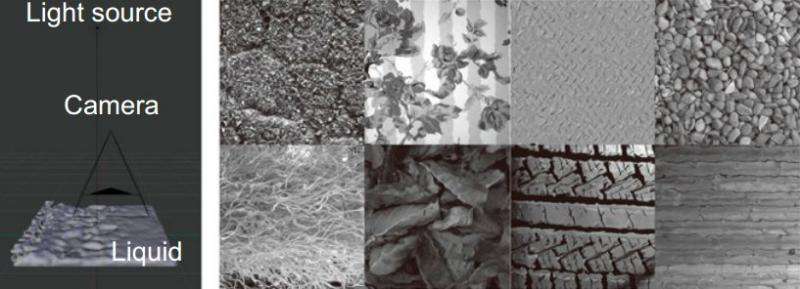PNAS 2015 ; published ahead of print August 3, 2015, doi:10.1073/pnas.1500913112
(Medical Xpress)—The adaptive advantage of the visual perception of transparency is obvious: the urgent need to find water. Thus, human vision is able to perceive two layers at the same retinal location—a transparent layer in front of a background surface. There are multiple cues indicating the presence of a transparent layer, including the pattern of luminance and color change at the junction of the overlapped layers, surface specular reflections, and intensity modulations.
However, such cues may not be visible in the case of perfectly transparent surfaces such as glass or completely still water. Even in the absence of such visual cues, the human visual system is often able to determine the presence of a transparent layer, suggesting that humans are also sensitive to alternative cues.
In a recent study published in the Proceedings of the National Academy of Sciences, a group of Japanese researchers suggest that the human visual system also uses image deformation caused by refraction as an alternative cue for a transparent layer. To test their theory, the researchers recruited eight observers with normal or corrected-to-normal vision, who were not told the purpose of the experiment. Using the open-source graphics software Blender, the researchers simulated transparent liquid flow. The use of software-based imagery allowed them to remove certain visual cues, such as surface specular reflections, and to expose the observers only to those visual cues they wanted to test.
Specifically, they set the refraction index and kinematic viscosity to that of water, with a water depth of 10 cm. In a dimly lit room, observers were asked to rate the strength of the transparent liquid impression on a five-point scale.
Example movies of stimuli in one experiment. Credit: PNAS 2015 ; published ahead of print August 3, 2015, doi:10.1073/pnas.1500913112
The results of the study, including supplementary experiments to rule out alternative explanations, indicate that humans rely on very simple, low-level sensory computations that check for the presence or absence of image distortion within specific spatiotemporal ranges. The authors note that when shown static images, observers rely on specular reflections and boundaries to determine the presence of a transparent layer; static deformation of the background is a relatively weak cue, and in the absence of the other cues, static images did not score highly for the presence of a transparent layer.
"The low rating score for the static image condition suggests that a static deformation image cannot provide a clear impression of transparent liquid, in agreement with a previously reported suggestion," the authors write. Dynamic deformation, as in the computer-generated video display used in the experiment, provided changing diffraction over time, a much stronger stimulus for the perception of a transparent layer.
Example movies of stimuli in another experiment. Color maps show the amplitude and direction of dynamic image deformation. Credit: PNAS 2015 ; published ahead of print August 3, 2015, doi:10.1073/pnas.1500913112
"Our findings indicate that the brain can perceptually infer the presence of 'invisible' transparent liquids by analyzing the spatiotemporal structure of dynamic image deformation, for which it uses a relatively simple computation that does not require high-level knowledge about the detailed physics of water deformation," the authors write.
Interestingly, the perception of a transparent surface was relatively stronger when natural images such as pebbles were used as the background, though the perception of a transparent layer also occurred for randomly generated synthesized backgrounds. In the presence of dynamic image deformation caused by an undulating, transparent surface layer, no other image cues are needed.
More information: "Perceptual transparency from image deformation." PNAS 2015 ; published ahead of print August 3, 2015, DOI: 10.1073/pnas.1500913112
Abstract
Human vision has a remarkable ability to perceive two layers at the same retinal locations, a transparent layer in front of a background surface. Critical image cues to perceptual transparency, studied extensively in the past, are changes in luminance or color that could be caused by light absorptions and reflections by the front layer, but such image changes may not be clearly visible when the front layer consists of a pure transparent material such as water. Our daily experiences with transparent materials of this kind suggest that an alternative potential cue of visual transparency is image deformations of a background pattern caused by light refraction. Although previous studies have indicated that these image deformations, at least static ones, play little role in perceptual transparency, here we show that dynamic image deformations of the background pattern, which could be produced by light refraction on a moving liquid's surface, can produce a vivid impression of a transparent liquid layer without the aid of any other visual cues as to the presence of a transparent layer. Furthermore, a transparent liquid layer perceptually emerges even from a randomly generated dynamic image deformation as long as it is similar to real liquid deformations in its spatiotemporal frequency profile. Our findings indicate that the brain can perceptually infer the presence of "invisible" transparent liquids by analyzing the spatiotemporal structure of dynamic image deformation, for which it uses a relatively simple computation that does not require high-level knowledge about the detailed physics of liquid deformation.
Journal information: Proceedings of the National Academy of Sciences
© 2015 Medical Xpress























